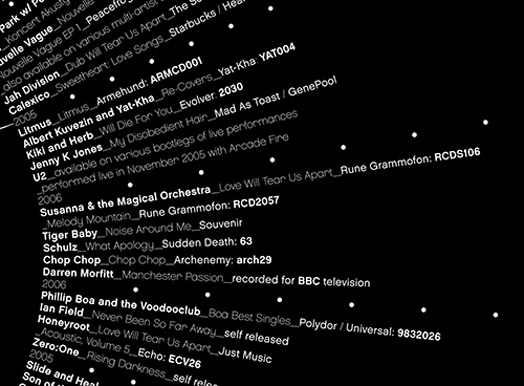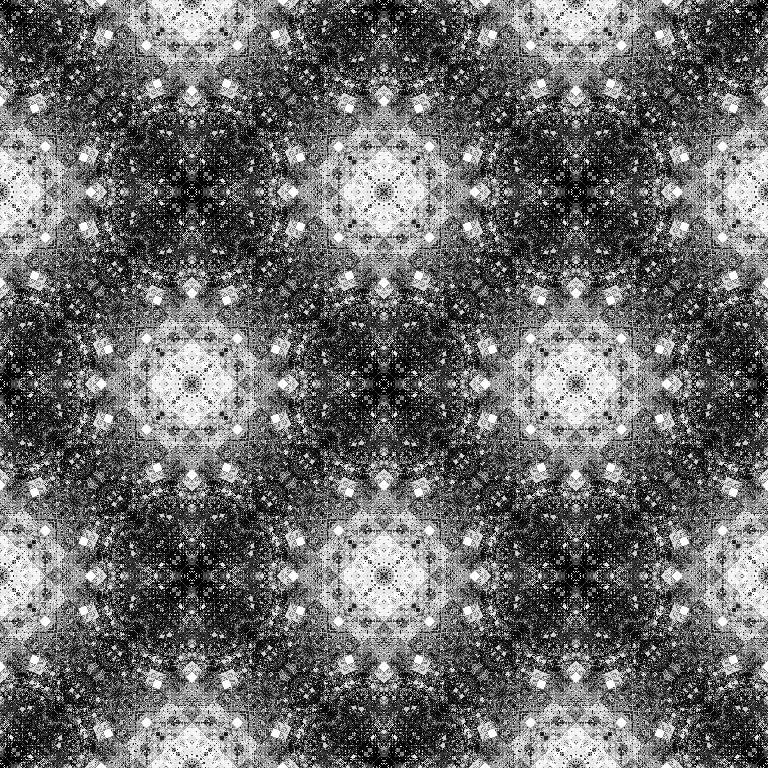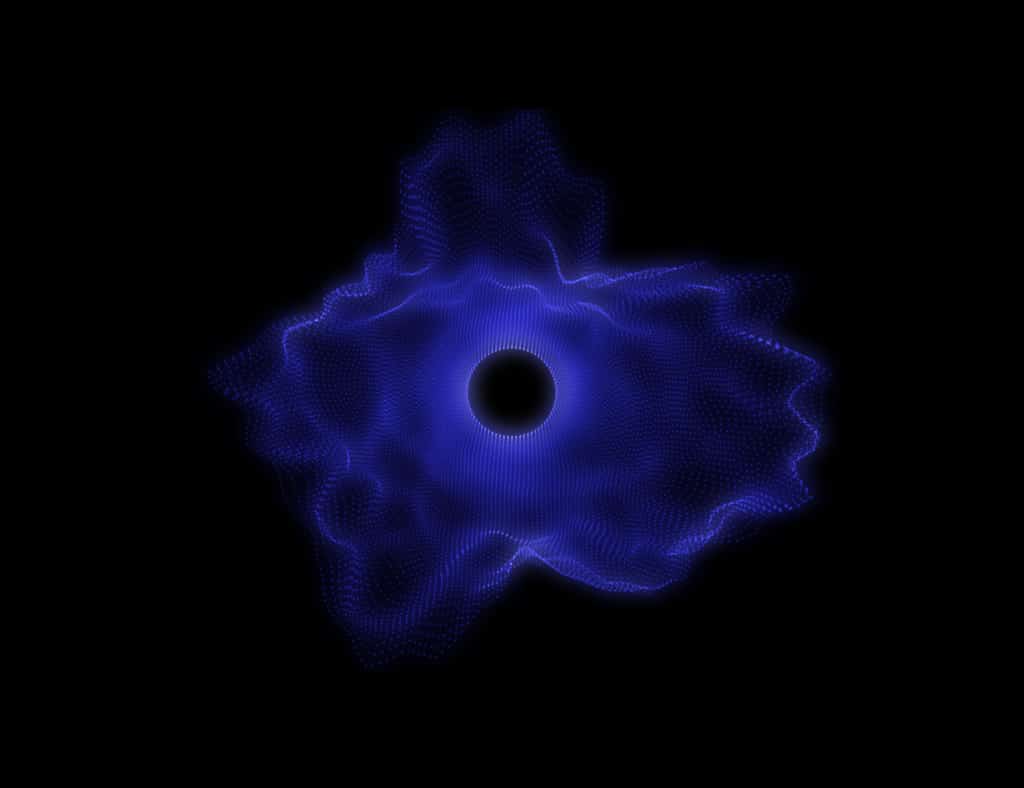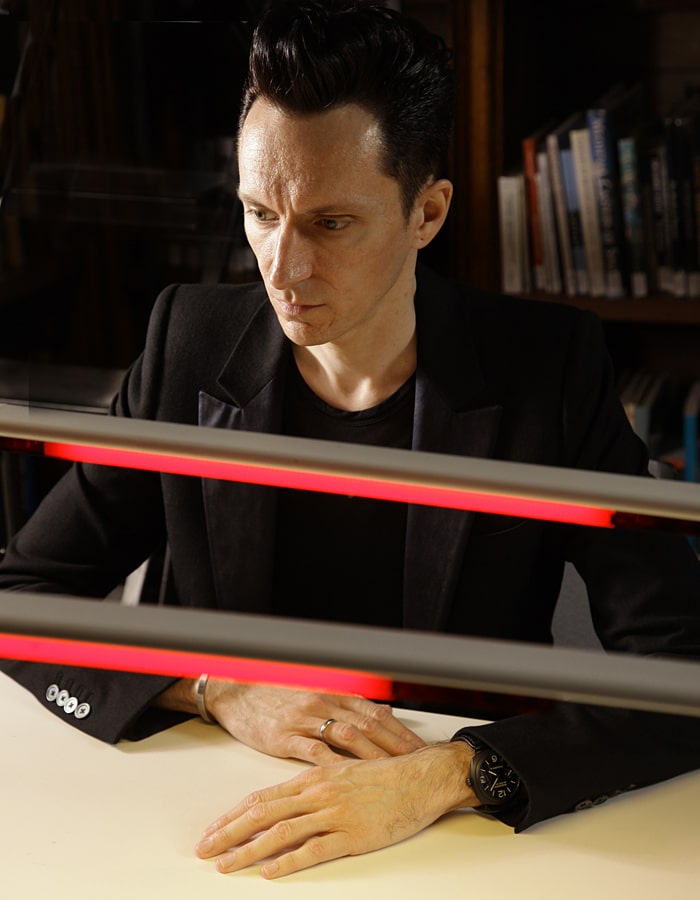The Croatian-born 3D computational artist, geneticist and ‘data-friendly Elvis’ on the beauty of maths, transmitting emotions as visuals and data selfies.

The Luxury of Protest is the nom de guerre of Peter Crnokrak
Peter Crnokrak:
“I make art from math. I used to be a quantitative geneticist – the study of nature versus nurture – but purely numbers. Now I use numbers to be expressive as a computational artist.
Data visualisation is the new poetry. Poetry exists to use a vehicle to try to impart experience onto someone else, so it’s the bridge between one thing and another. My work revolves around emotions and connectivity.
You can never see the forest from the trees. At the moment all we are able to see are the trees, but the forest is much more important. That’s big data.

Peter talks about engineering intelligent objects fed by our personal data through symbols at the NYTimes for Visualized. Good hair day.
Equations try to characterise the universe. They try to understand why things are ordered the way they are, why trees grow the way they grow. I visualise those basic mathematical equations to strip away their esoteric nature.
Math is beautiful. People always say, “What does it look like?” When I show them complex projects under the moniker of The Luxury of Protest, they get it.

The Golden Ratio: “This is so simple. Everything (angles, lines lengths, scaling) is based on one number – the divine proportion.”
Beauty is very hard to define. It is often the pathway to understanding. When it comes to data visualisation, it is about simplicity, taking complexity and creating a pathway that allows you to experience it.
I don’t tell people what they are looking at. Then I tell them: “This is actually just math. This is what it looks like.” The L-system algorithm is a very simple equation trying to predict how plants grow. What’s fascinating is the simple visual of it.

The L-system: “You do not need to know what this is based on. The complexity and order is beautiful. It’s not chaotic.”
Most of my projects deal with the human condition. It’s about understanding people’s place in either history or the present state. A lot of my earlier projects were political, so they were surveys essentially, for example, the contribution of conflict in human society. I’m trying to impart a feeling.
The way the city of Detroit looked changed the way I am. The decay and romantic aspect of ruins are stunning. A lot of my work is highly detailed and I’m sure it comes from all the piping that’s exposed there.
I loved British indie music. As a kid I thought if I could only move to Manchester all my dreams would come true.
Wealthy people don’t produce culture. Unless you are pushing yourself what is the point?

The World Within Me Is Outside Me: “This is a mathematical modelling of the cumulative wave interference of droplets of water on a pond.”
Music for me is everything. When transcribing it into visuals, you are using a different set of stimuli – your eyes instead of your ears – to understand something that words just won’t cut, like when you try to describe a smell.
In ‘What Need Angel’, I took listening to music and distilled it down into data. I used an EEG headset to measure the responses of a five-year-old listening to the electronic music of London producer Burial. Complex emotions are transcribed into something relatively simple.
This is engineered synaesthesia. The EEG measures your brainwaves’ response to any kind of stimuli, and determines whether you are in a relaxed, excited, engaged, daydreaming or bored. The pattern from the music listening experience is matched to a pattern formed by viewing visuals in a lock–and–key type system: the music data is the lock that is matched to data equivalent visuals that form the key.
‘I think, you feel’ is totally possible. This EEG headset is the bridge between your mind and the outside world. It allows you to use your brain as your hands. So if you are disabled, you could cross that bridge of non-physicality by simply thinking. Imagine if you could cross it further, where my mind is connected to yours?
Can you transmit emotions? Imagine if the EEG can transcribe you kissing someone and feeling that swell of love. Then imagine if that data can be transmitted to anything like a human computer, an interface of sorts.
Getting drunk helps you to relax to get a better perspective on life. If you can impart the empathic experience of others in other individuals this is the greatest service you could provide for the human being.
When you are connected to someone you tend to care about them more. But you also change your behaviour and become a better person because you feel responsible.

I can see your HALO
HALO is my data visualisation software. It represents you as a physical being, a multi-dimensional creature that moves and changes shape based on your data. Using sensors, like those on an Apple watch, you can be represented digitally, so instead of using a bar graph to show how many steps you’ve gone in a day, you have your HALO growing over time – like a sea anemone Tamagochi.
Your HALO could be based on anything – like sex. It is fed off heart rate, blood pressure, even perspiration depending on the wearable that you use. It is engineered so you have an empathic connection to this digital representation of self.
My next product is a ‘data selfie’. Imagine I don’t know you. I meet you in a bar, fancy you, and then befriend you on Facebook. You go through my images to see who I am, but it only gives you a pictorial idea. Imagine if there’s a way I can give you a quantitative measure to represent yourself on social media with data? Everyone wants to know the genuine person. That will take years to do though – definitely in the future!
We’re now in a post-data world. Post-data doesn’t mean it’s not concerned with data – far from it. The term refers to what follows after the social acceptance of data. Now that data visualisation and the technical language associated with it are firmly ensconced in culture, we’re asking what’s the next step in cultural evolution possible using the technology.
If I was to have a FutureHero superpower… it would be to make people understand how each of us understands. (Or I would be invisible so I could touch boobs!)”
Peter Crnokrak was talking to Atlas Editor Lisa Goldapple. Read more about more about HALO, and the people and projects that inspire the artist in his AtlasChart Top 5 – from satellite archaeology to the Pope being the ultimate crossover act. [Main photo: Ivan Jones]


THE DIVINE IMAGINATION HAS NO BOUNDARIES.